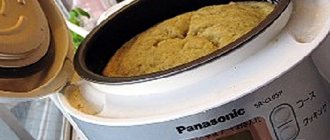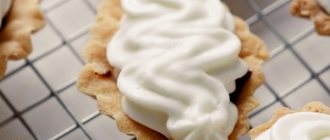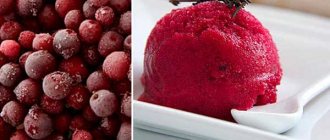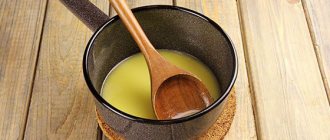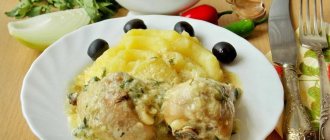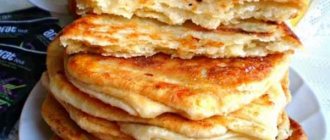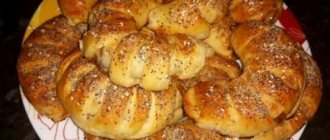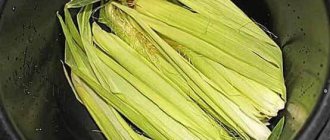March 19, 2015
Seal
- #woman
- #yeast dough
- #Kulich
- #Easter
- #Polish cuisine
- #baking
- #French cuisine
Categories: Rolls and buns, Other desserts, Classics, Polish cuisine, French cuisine, Easter
In my opinion, well-prepared rum baba is one of the most delicious desserts. And the addition of cream and fruit makes the pleasure even more complex. Previously, I published a recipe for punch cake, that is, babka, according to a recipe from an old Polish book, where it was called babka punchova and had a different method of impregnation, but also with syrup and rum. This same babka is my interpretation of the baba recipe from the French culinary encyclopedia Larousse Gastronomique. It is richer and richer in taste. I really love baked goods soaked in light alcoholic syrup, so I think there can never be too much of it :-)!
In general, although the French attribute the recipe to themselves (they have such a national peculiarity that they attribute the invention of most of the world's popular culinary dishes to themselves, although in fact someone long ago only started some kind of legend, where France was mentioned where), the rum baba is Polish roots. Although in France this pastry is widespread and usually has a somewhat comical shape, small cylinders and by no means babka. And around the very appearance of a woman soaked in alcohol, there are many legends associated with the Polish king Stanislav Leszczynski. According to one legend, he simply loved to soak the traditional Polish yeast baked goods, babka, in dessert wine. His regular pastry chef, in order to please the king, soaked the babka in alcoholic syrup. According to another legend, during one of the king’s travels, the babka simply dried up, and the royal pastry chef solved the problem by soaking the babka in dessert wine. According to another legend, which I have previously written about, Stanislav Leszczynski, while in the vicinity of Alsace and Lorraine, treated himself to local kugelhopf pastries, similar to the traditional Polish babka, and these pastries seemed dry to him, so the king dipped pieces of yeast pastries into dessert wine. But somehow kugelhopf poorly fits into history, because babka is a traditional Polish pastry from ancient times, crowned heads traveled everywhere with their retinue, their culinary specialists and pastry chefs, so the chances of trying something cooked by someone other than their own pastry chef are very small, even taking into account the issue of security at that time .
The first mention of the use of rum in syrup to impregnate rum babka was in 1835. And in 1844, the Julien brothers “invented” the savarin, which they were “inspired by” by the baba, but in fact, it is a miniature baba, only of a different shape. The only difference is that rum baba is not always decorated with whipped cream and fruit, but savaren, as a rule, is always. But this is not enough for the proud French to claim that they have come up with something. But it’s not surprising, baba is so delicious that it’s not surprising that someone wants to put a copyright stamp on it.
The dough is not easy to prepare! It is liquid and sticky, but the dough turns out to be airy and light and then comes out!!! To the surprise of all post-Soviet housewives who firmly believe that properly prepared yeast dough should not stick to your hands! Nonsense and nothing more! Battery dough, with reasonable proportions and proper handling during rising and after transferring to the mold, rises better, and finished products from such dough are loose, with a huge number of small holes. Such products will never be whipped and hard. But, you need to be careful with the dough after transferring it to the mold, especially if it has already begun to grow. You cannot knock the molds, pound them on the table surface, and even place them in the oven very carefully so that there are no shocks or unnecessary shocks, because such dough quickly falls off with such careless manipulations. It is also very important to avoid drafts while the dough is fermenting. This is also important for the fermentation of any yeast dough, but such sticky dough is especially vulnerable to drafts.
But in no case do I urge you to thoughtlessly change the usual recipes for tight yeast dough, adding liquid by eye to make it wet and sticky. In baking, all proportions must be well thought out and balanced. A change in the amount of one ingredient entails a change in the amount of all the others.
Don't be afraid to pour syrup over your baba. Baba should be well soaked, literally wet. Instead of rum, you can use cognac or another strong alcoholic drink, then the women will no longer be rum, but named in accordance with the drink you have chosen.
If you are not going to serve the baba right away, I do not advise you to decorate them in advance. Can be soaked and decorated before serving. Although you can bake it in advance and soak it an hour before serving. The syrup can be prepared ahead of time, just warm it up a little before soaking.
I add a small amount of gelatin to the syrup. Not enough to create a jelly, but enough to better retain moisture and freshness in the baba.
1 big woman and 2 small or 2 medium women
Ingredients
- 550 grams flour
- 40 grams of fresh yeast
- 120 grams butter
- 7 eggs
- A pinch of salt
- 100 grams of sugar
- 50 ml milk
- 100 grams of raisins
- Rum for soaking raisins
- Flour for rolling raisins
- Butter for greasing molds
For the syrup:
- 1 liter of water
- 350 grams of sugar
- 50 ml honey
- 70 ml rum
- 6 grams gelatin
- Zest of 1 orange
For decoration:
- 300 ml cream 30%
- 100 grams of powdered sugar
- Seasonal fruits
Cooking time: 5 years
1) Place raisins in a deep bowl, pour boiling water over them, strain and fill to the top with rum. Leave for 2-3 hours.
2) Grind the yeast with milk until smooth.
3) Beat eggs with sugar and a pinch of salt.
4) Add flour, yeast and melted butter. Knead until smooth, sticky and fairly liquid dough, knead with your hands or a wooden spoon for 7-8 minutes, 3-4 in a planetary mixer.
Cover the bowl with the dough with a slightly damp towel or lid. Leave for 1 hour 30 minutes in a warm, draft-free place.
5) Strain the raisins. Rum can be used to make syrup for soaking rum baba. Dip the raisins in a small amount of flour.
6) When the dough has risen, punch it down.
Add raisins and knead everything together again.
7) Preheat the oven to 180°C.
 Grease round muffin tins (also traditional for babkas) or Easter cakes with butter and fill them halfway with dough.
Grease round muffin tins (also traditional for babkas) or Easter cakes with butter and fill them halfway with dough.
Without covering anything, leave to rise for 30-45 minutes. The dough should rise to almost the entire height of the pan.
9) Place the pans with the dough into the preheated oven and bake for 30-45 minutes, depending on the size and operation of the oven. Check the baba for doneness using a toothpick or wooden skewers. Insert deep into the center and a toothpick should come out clean.
10) Remove the babkas from the oven, leave as is for 5 minutes, then carefully remove from the pan and place on a cooling rack. Before soaking in rum syrup, the women must cool completely.
11) Meanwhile, prepare the syrup for the rum baba:
— Place water, honey, sugar and zest in a small saucepan. Bring to a boil and cook, stirring, until the sugar is completely dissolved. Remove from heat and pour in rum. Set aside to cool.
— Place the gelatin in a small bowl and add a small amount of water. Leave to swell.
As the gelatin swells, transfer it to warm syrup. Remove the zest and stir the syrup until the gelatin is completely dissolved.
12) Soak with slightly warm baba syrup:
The easiest way is to place a wire rack on a baking sheet. Immerse the babkas in a bowl with syrup, first the top and then the bottom, and place the babkas bottom up on the wire rack.
Do this with each babka, and then pour the remaining syrup over each one.
The babki should be completely soaked in cheese.
Excess syrup will gradually drip onto the baking sheet. Leave them like this for at least one hour.
Then turn the rum baba over and place on a serving bowl.
Beat cream with powdered sugar.
Decorate the top of the babka with cream and seasonal fruits.
Can be served.
Store rum baba in the refrigerator for no more than 2 days.
Bon appetit!
See also
Ingredients:
Dough:
- chicken egg 5 pcs,
- butter 200g,
- wheat flour 500-550g,
- dry instant yeast 6g,
- sugar 100g,
- salt 1 pinch.
Impregnation:
- water 250 ml,
- rum 100 ml,
- lemon zest 1 piece,
- orange zest 1 piece,
- powdered sugar or sugar 100g,
- vanilla sugar 1 tsp.
For decoration:
- cream 150g,
- condensed milk 100g,
- multi-colored candies to taste.
Recipe for rum baba according to GOST for 1 kg of products
- 260 g of sourdough or low-acid sourdough (130 g of water, 130 g of white flour, 30 C, 2 hours of fermentation)
- 282 grams of whole grain flour
- 1/4 tsp. salt (1.24 g)
- 10-21 g compressed yeast
- 103 g sugar
- 103 g unsalted butter
- 82 g eggs
- 52 grams of raisins in the dough
- a couple of spoons of natural vanilla extract
Knead the dough until the gluten is well developed (1 minute 30 seconds in a food processor with a special dough blade), fold in the raisins by hand. The dough at the end of kneading should be very warm, approximately 35 C. Let the dough ferment in a very warm place (35-40 C), doing two kneadings: each time the dough increases in volume by 1.5-2 times, kneading it successively.
Cut the dough into pieces of such size that they fill the molds 1/3 or 1/4 and pull the pieces of dough into balls. Place them in greased or non-stick pans with the knot (tuck) facing up. Large babas can be baked in conical brioche, kugelhopf or savarin tins, with smooth or corrugated sides, preferably in tins with a tube in the centre. If the baba is baked in the form of a pie, then roll out the dough into a layer, place it in a greased baking sheet and prick it. Cover the molds or baking sheet with the dough with film.
Let it rise in a very warm place for 40-60 minutes (the pieces will grow 2-3 times in volume), brush with egg and bake at 180 degrees for 25 minutes, for small and medium-sized babas (from pieces of dough weighing 25-50 grams ) or bab-pies or longer for large babkas weighing up to 1 kg. Large babas weighing 0.5 - 1 kg will have to be covered with foil in the second half of baking to prevent them from getting burnt.
While the dough is fermenting, prepare the syrup for soaking and sugar fondant. After the babas have cooled in the molds, remove them and place them with the narrow end up. Let them dry thoroughly and ripen for a few hours. They will become dry and hard to the touch. Pour cognac, rum or cognac essence into the syrup, which has cooled to 20 C, and stir. Heat the lipstick to 55 C, until it flows, or store it warm, liquid. Prick the narrow end of each baba several times with a thin stick, piercing the crumb approximately to the middle of the cupcake. If the baba was baked in the form of a pie, then often prick the pie itself.
First, soak the babas in syrup by lowering the product into the syrup with the narrow end and lightly squeezing the babas so that it absorbs the syrup. The smaller the baba, the more syrup it is soaked in. Very large women are only lightly soaked in syrup, otherwise they will later sag under the weight of the very heavy syrup-drenched top. Place the soaked babas with the narrow end up so that the syrup can penetrate into the thickness of the crumb, under the weight of its own gravity. The pie in the pan is simply poured with syrup and allowed to penetrate into the crumb of the product before thickly pouring fondant over the top of the pie.
To glaze a baba with lipstick, take the wide end of the baba and lower the narrow end into a cup or saucepan with warm, pouring lipstick. You can glaze just the very top of the baba, or glaze the whole thing - both the top and the sides. Remove, swirl to spread the fondant evenly over the top or top and sides, and place the cake on a wire rack or baking sheet, narrow end up. The surface of the glazed rum baba is decorated with raisins, candied fruits and fresh or canned fruits, a mesh of colored lipstick, etc. After some time, the lipstick will cool and become dry to the touch and creamy like candy inside. Such a woman can already be served. She's ready.
Syrup for soaking rum baba
- 510 g sugar
- 560 g water
- a few drops of rum essence
- 50 g cognac or rum
Sugar and water are boiled, stirring constantly, to 103.1-103.5 C (medium syrup, density 1.22-1.25), that is, until it boils down from a weight of 1070 g to a weight of 950 g. Cool the syrup to 20 C and add rum essence, cognac or rum.
Rum baba at home - recipe
Interesting, but the history of the origin of this dessert is very controversial. Some sources consider it to be originally Slavic: baba - grandmother, and put the emphasis on the first syllable.
Other sources attribute it to Eastern origin and recommend pronouncing the name with an emphasis on the second syllable, as in the name Alibaba. But in the kitchen it doesn’t matter what anyone calls it. What's interesting here is how to make rum baba at home.
My recipe does not claim the high title of “classic”, but we like it and also leaves some room for imagination.
For impregnation, syrup is usually prepared with the addition of rum, as the name implies. We don’t have rum, and it doesn’t exist; we are small connoisseurs of alcohol. There was cognac and I added it to the protika. Again, if you have small children, you don’t have to add alcohol to the impregnation; it won’t have a big impact on the taste of the finished product. The syrup in my recipe is strawberry.
Someday I'll show you how to cook it at home. But today I will give you a recipe for regular sugar, which can serve as the basis for impregnation. Add any berry or orange juice to it and it will be delicious. Usually, after soaking, the top of the baba is covered with sugar glaze; its recipe will be below.
If you want, please, I limited myself to just sprinkling with powdered sugar and decorating with fresh strawberries.
Ingredients:
- flour - 1.5 cups* (220g);
- sugar – 2 tbsp. (50g);
- dry instant yeast - 2.5 tsp. (20g);
- milk – 0.5 cups (125 ml);
- eggs – 2 pcs;
- butter – 80g;
- cognac (or rum) – 1 tbsp;
- sugar for syrup - 1 cup and 2 tbsp. (250g);
- water – 1.5 cups (300ml).
Preparation
- For yeast dough, you first need to prepare the dough. Warm the milk a little so that it is a little warmer than body temperature. Add a pinch of sugar, yeast and 1 tablespoon of flour. Stir and leave in a warm place for 10 minutes to allow the dough to rise.
- While the dough is rising, heat the butter, which should cool slightly.
- After 10 minutes you will see a risen dough like this in the bowl.
- The dough for rum baba can be kneaded either by hand or using a food processor with a hook attachment. It's easier with a combine. Add all the remaining flour and 2 tablespoons of sugar to the dough. Mix.
- Once the added ingredients are combined, break the eggs into the bowl one at a time, stirring after each addition.
- Pour in the butter, knead for 10 minutes and end up with a sticky, liquid dough.
- We need it to rise. Cover the bowl with cling film and leave warm for 1 hour. During this time it will increase in size, but will remain sticky.
- As I already wrote above, to bake the rum baba I used a springform cake pan, its diameter is 18 centimeters, and the height of the sides is 6.5 centimeters. It must be greased with butter. In the oven, the baked goods will rise well and take up almost the entire volume. We leave the dough to rest for 40 minutes after we disturbed it.
- Meanwhile, preheat the oven to 190°C. Bake in a preheated oven for 25-30 minutes. If you notice the outside starting to burn, cover with foil. After half an hour, check the readiness with a wooden skewer or toothpick. First cool the finished product in the mold for 10 minutes, then remove it, but do not remove the mold, we will need it later.
- Now let's move on to impregnation.
I had the syrup ready, I needed to bring it almost to a boil, pour in cognac or rum. If you don’t have anything ready, you can cook it. It's quick and easy. Pour sugar in the amount indicated in the list of ingredients into a small saucepan with a thick bottom, add water and, stirring constantly, heat until the sand dissolves and the liquid begins to boil. At this stage, you can add fruit or berry juice for flavoring. A few spoons will be enough. Continue cooking over low heat for another 10 minutes. - Pour the hot syrup into the mold in which the babka was baked. We lower the headstock into it upside down, bottom up. Leave it in this position until everything is absorbed. Then we turn it over onto a dish, decorate with berries or fruits (strawberries in my version), sprinkle with powdered sugar and you can drink tea with delicious, soft and well-soaked rum baba! Save the step-by-step recipe with photos and try it.
Babka dough and baking
- flour – 369g;
- sugar – 94g;
- butter – 92g;
- eggs – 74g;
- yeast – 18g;
- salt – 1g;
- water (or milk) – 120g;
- raisins – 46g;
- vanillin – 2g.
Yes, these are the quantities. Let's try to translate what we don't understand into a modern manner:
- 100 grams of water equals approximately 98.88 ml. For our baking, we take 120 ml and don’t bother;
- milk weighs more than the same volume of water and 100 grams equals 97 ml, i.e. 120 g equals approximately 116 ml. I think in our case we take 120 ml;
- The average weight of 1 egg is 60 grams, which means 74 grams of eggs is 1 little bit, so we take 1 large one.
The indicated quantity is enough for a large headstock weighing about 1 kg.
- Since the dough is very rich, it needs to be prepared using the sponge method. Heat the water (or milk) to a temperature of 30-35°C and dissolve it into yeast. It is worth noting that in this case we are talking about live yeast, and not about their fast-acting relatives. Sift half of the flour into a bowl. We get a batter similar to sour cream in consistency. Sprinkle flour on top, cover with a towel or film and leave for 3.5-4 hours in a warm place.
- The yeast will start working, carbon dioxide will be released, bubbles will appear on the surface of the dough and it will increase in volume, but by the end of the specified time it will settle and this is a signal to add the remaining ingredients (except for raisins and vanillin).
- Then leave for another 1-2 hours. During this period we knead once.
- Add raisins (if necessary, pre-soak in water) and vanillin.
- Arrange into shapes. The classic headstock is a conical, truncated corrugated one with a tube in the middle. Not every housewife has one, so we take any of our choice. You can use silicone or non-stick ones with cells for muffins, muffins, cupcakes or Easter cakes, or make them as in the recipe above. Be sure to grease the molds with butter.
- Let it sit for some time and double in size. Place in an oven preheated to 220°C for 45-50 minutes.
- When the babka is baked, first remove it from the oven, cool it in the pan for 10 minutes and remove it.
- Oddly enough, GOST advises soaking confectionery products not immediately, but after “ripening”, after 12-14 hours. But this is good, because we still need a lot of time for soaking and fudge. Let's start with the second one.
Fudge recipe
- sugar – 207g;
- molasses – 21g;
- water – 65g (65 ml).
Molasses... it's not there, right? Replace with an equivalent amount of granulated sugar and increase the amount of water to 100 g (100 ml).
- Pour sugar into hot water, stir and wait for dissolution. Place on the stove and cook the syrup. When foam forms on the surface, remove from heat and put away, then return again.
- Increase the heat to maximum and cover with a lid. A lid is required; a greenhouse effect is formed under it and splashes falling from the boiling syrup onto the walls of the pan do not crystallize.
- Cook to a temperature of 110°C. If you don’t have a thermometer, do a ball test (for more details, see the recipe for eclairs with custard protein cream).
- Now the syrup needs to be cooled quickly. Why put the container in cold water with ice. While it cools, spray the surface with water to prevent crystals from forming. Cool to a temperature of 30-40°C.
- Take a mixer and beat. After 10 minutes of beating, it should turn white and turn into a lump. If this does not happen, add powdered sugar.
- You cannot immediately cover the baba with lipstick. It will also ripen for 12-24 hours in cling film or a damp cloth. After ripening, the consistency will change and become soft and viscous.
Towards the end of the lipstick's aging time, we prepare the impregnation.
Impregnation recipe
- sugar – 40g;
- cognac – 4g;
- rum essence – 0.8g;
- water – 44g (44 ml).
The last step and we are at the goal.
- Bring the water to a boil, add sugar, bring to a boil again, skim off the foam and turn off. Waiting for it to cool down to warm (20°C). Add rum and/or cognac.
- We dip our product into the impregnation “head down”. Leave in this position so that the syrup is absorbed.
- To cover the baked goods with fondant, separate a small piece and heat until it becomes liquid sour cream. But don't overheat! She might melt completely!
- Remove the babka from the syrup and dip the same side into the fondant. And finally everything is ready!
What can I say... If you came to this page looking for a GOST recipe, then I have a question for you: do you still want to cook baba at home using it? Or maybe the first one, the homemade one, the simple one, huh?
In any case - bon appetit!
Source: https://blog-recept.ru/romovaya-baba-poshagovyj-recept-s-foto/
